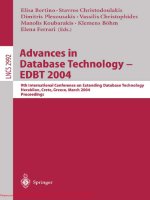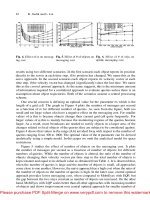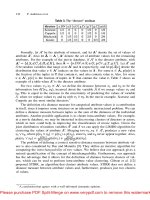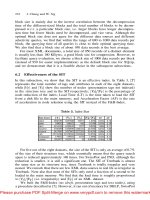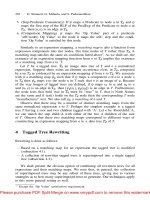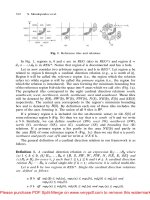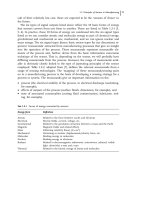Tài liệu ADVANCES IN URBAN ECOLOGY pptx
Bạn đang xem bản rút gọn của tài liệu. Xem và tải ngay bản đầy đủ của tài liệu tại đây (7.02 MB, 379 trang )
ADVANCES IN URBAN
ECOLOGY
ADVANCES IN URBAN
ECOLOGY
Integrating Humans and
Ecological Processes in Urban
Ecosystems
by
Marina Alberti
University of Washington
Seattle, Washington, USA
Marina Alberti
University of Washington
Seattle, Washington, USA
ADVANCES IN URBAN ECOLOGY:
Integrating Humans and Ecological Processes in Urban Ecosystems
Library of Congress Control Number: 2007936241
ISBN-13: 978-0-387-75509-0 e-ISBN-13: 978-0-387-75510-6
Printed on acid-free paper.
© 2008 Springer Science+Business Media, LLC
All rights reserved. This work may not be translated or copied in whole or in part without the written
permission of the publisher (Springer Science+Business Media, LLC, 233 Spring Street, New York, NY
10013, USA), except for brief excerpts in connection with reviews or scholarly analysis. Use in connec-
tion with any form of information storage and retrieval, electronic adaptation, computer software, or by
similar or dissimilar methodology now known or hereafter developed is forbidden.
The use in this publication of trade names, trademarks, service marks, and similar terms, even if they are
not identified as such, is not to be taken as an expression of opinion as to whether or not they are subject
to proprietary rights.
9 8 7 6 5 4 3 2 1
springer.com
Cover Design: Eric Knapstein
To Antonio, Leda
and Matteo
CONTENTS
PREFACE…………………………………………………………………
xi
ACKNOWLEDGMENTS
……… ………………………………………….xvii
1.2 Cities as Human Systems …………………………………… 15
1.3 Cities as Ecological Systems………………………………….
16
1.4 Cities as Hybrid
1.5 Complexity, Emergent Properties, and Self-Organization… 20
1.6 Resilience in Urban Ecosystems………………………………
22
1.7 Rationale for a Synthesis…………………………………… 25
Chapter 2 HUMANS AS A COMPONENT OF ECOSYSTEMS……
27
2.1 Emergence and Evolution of Settlement Patterns
………………29
2.2 Modeling Urban Development and Ecology………………….
34
2.4 Modeling Changes in Land Use and Land Cover……………
49
Chapter 3 URBAN PATTERNS AND ECOSYSTEM FUNCTION…61
3.1 Patterns, Processes, and Functions in Urban Ecosystems
….…. 61
3.4 Nutrient Cycles.…………………………………………….… 81
3.5 Biodiversity……………………………………………………82
3.6 Disturbance Regimes…………………………………………. 85
3.7 An Empirical Study in Puget Sound………………………… 86
Chapter 4 LANDSCAPE SIGNATURES…………………………… 93
4.1 Hybrid Urban Landscapes……………………………………. 93
4.2 Gradients, Patches, Networks, and Hierarchies……………….95
4.3 Urban Landscape Signatures……………………………… 103
4.4 Measuring Urban Landscape Patterns………………………. 112
Ecosystems………………………………….
17
2.3 An Agent-Based Hierarchical Model…………………………
43
3.3 Hydrological Function……………………………………… 79
3.2 Net Primary Productivity…………………………………… 78
Chapter 1 THE URBAN ECOSYSTEM……………………………… 1
1.1 The Dynamics of Urban (Eco)Systems…………………….… 8
2.5 Changes in Land Use and Land Cover in Puget Sound
… 54
Advances in Urban Ecology
viii
4.5 Detecting Landscape Patterns in Puget Sound…………… 117
4.6 Monitoring Landscape Change in Puget Sound……………
126
Chapter 5 HYDROLOGICAL PROCESSES………………………
133
5.1 The Urban Hydrological Cycle………………………………
133
5.2 Urban Hydrological Functions
…………………………………. 137
5.3 Human-Induced Changes in Urban Watersheds……………
144
Chapter 6 BIOGEOCHEMICAL PROCESSES…………………….
163
6.1 Urban Biogeochemistry……………………………………
163
6.2 The Carbon Cycle…………………………………………… 167
6.3 The Sulfur Cycle……………………………………………
170
6.4 The Phosphorus Cycle
……………… ………………………… 172
6.5 The Nitrogen Cycle…………………………………………
174
Chapter 7 ATMOSPHERIC PROCESSES………………………….
183
7.1 Tropospheric Ozone………………………………………….
183
7.2 Urban Air Quality and Climate Change
……………………… 186
7.3 Urban Heat Islands
……………… …………………………… 187
7.4 Urban Patterns and Air Quality
………….………………… … 194
Chapter 8 POPULATION AND COMMUNITY DYNAMICS
197
8.1 Biodiversity, Ecosystem Function, and Resilience…………
197
8.2 Urban Patch Dynamics……………………………………… 207
8.3 Urban Ecosystem Processes and Biodiversity……………….
210
8.4 The Intermediate Hypothesis: A Case Study
9.2 Complexity and Predictability……………………………….
227
9.3 Spatial and Temporal Heterogeneity
………… ….………… 231
9.4 Threshold, Discontinuity, and Surprises
….…… …………… 232
10.1 A Hybrid Ecology…………………………………………
251
10.2 Toward a Theory of Urban Ecology………………………
254
Chapter 9 FUTURES OF URBAN ECOSYSTEMS…………….….
225
9.1 The Challenges: Complexity, Heterogeneity, and Surprise….225
9.6 Hypothetical Scenarios of Urban Ecosystem Functions……
242
Chapter 10 URBAN ECOLOGY: A SYNTHESIS…………………. 251
10.3 Building Integrated Models………………………………
261
6.6 Urban Patterns and Nutrient Cycling……………………… 176
9.5 Scenario Planning and Adaptive Management……………… 237
in Puget Sound
… ………….…………………………….…… 217
……………………152
5.4 Urban Patterns and Stream Biotic Integrity
Table of Contents
ix
10.6 A Final Note
………… ……………………………………… 270
10.4 A Research Agenda for Urban Ecology…………………… 263
10.5 Implications for Urban Planning
…………………………… 267
REFERENCES
………………………………………………………………. 277
GLOSSARY………………………………………………………… 273
INDEX……………………………………………………………………355
PREFACE
Natural and social scientists face a great challenge in the coming decades:
to understand the role that humans play in ecosystems, particularly urban
ecosystems. Cities and urbanizing regions are complex coupled human-
natural systems in which people are the dominant agents. As humans
transform natural landscapes into highly human-dominated environments,
they create a new set of ecological conditions by changing ecosystem
processes and dynamics. Urbanization changes natural habitats and species
composition, alters hydrological systems, and modifies energy flows and
nutrient cycles. Although the impacts of urban development on ecosystems
occur locally, they cause environmental changes at larger scales. Environ-
mental changes resulting from urbanization influence human behaviors and
It is critical that we develop an integrated approach at a time when
urbanizing regions are faced with rapid environmental change. Planners and
managers worldwide face unprecedented challenges in supporting urban
populations and improving their well-being while simultaneously main-
taining ecosystem functions. Agencies must devise policies to guide urban
development and make decisions about investing in infrastructure that
is both economically viable and ecologically sustainable. An integrated
framework is required to assess the environmental implications of alter-
native urban development patterns and to develop policies to manage urban
areas in the face of change. In particular, strategies for urban growth
management will require such integrated knowledge to maintain ecological
dynamics and affect human health and well-being.
Remarkable progress has been made in studying the impact of urban deve-
lopment on ecosystem functions (McDonnell and Pickett 1993, McDonnell
et al. 1997, Grimm et al. 2000, Pickett et al. 2001, Alberti et al. 2003), yet the
interactions and feedback between human processes and ecosystem dynamics
in urbanizing regions are still poorly understood. In this book I argue that new
syntheses across the natural and social sciences are necessary if urban and
ecological dynamics are to be successfully integrated into a common frame-
work to advance urban ecology research. If we remain within the traditional
disciplinary boundaries, we will not make progress towards a theory of urban
ecosystems as coupled human-ecological systems, because no single discip-
line can provide an unbiased and integrated perspective. Questions and
methods of inquiry specific to disciplinary domains yield partial views that
reflect different epistemologies and understandings of the world.
resilience by preventing development pressure on the urban fringe, reducing
resource use and emissions of pollutants, and minimizing impacts on aquatic
and terrestrial ecosystems.
Scholars of urban ecology have started to recognize the importance of
explicitly linking human and ecological processes in studying the dynamics
of urban ecosystems. Not only are human decisions the main driving force
behind urban ecosystems; changes in environmental conditions also control
natural systems have started to uncover new and complex mechanisms that
are not visible to either social or natural scientists who study human and
et al. 2003). Simply linking scientific diciplines is not enough to achieve the
level of synthesis required to see the urban ecosystem as a whole. Yet
virtually no plan exists for synthesizing these processes into one coherent
research framework.
What is new today is the acknowledgment that the sciences of ecology
and of cities have pretty much ignored each other until very recently. The
theoretical perspectives developed to explain or predict urban development
and ecosystem dynamics have been created in isolation; neither perspective
fully recognizes their interdependence. Ecologists have primarily studied the
dynamics of species populations, communities, and ecosystems in non-urban
environments. They have intentionally avoided or vastly simplified human
processes and institutions. Landscape ecology is, perhaps, the first consistent
ecological processes (e.g., fluxes of organisms and materials) in urbanizing
environments. Social scientists, on the other hand, have only primitive ways
to represent ecological processes. Neoclassical economics, for example, uses
xii
Advances in Urban Ecology
effort to study how human action (i.e., changing spatial patterns) influences
The idea that humans are an integral part of ecosystems and that cities
cannot be fully understood outside of their ecological context is hardly new.
The evolution of cities as part of nature dates back at least to Geddes (1915) if
not much earlier. Anne Spirn (1985) noted that an understanding of the
interdependence between cities and nature was already present in the writings
of Hippocrates (ca. 5
th
century BCE), Vitruvius (ca. 1
st
century BCE) and
Leon Battista Alberti (1485). During the last century, the idea took form and
evolved in initial areas of study in various disciplines including sociology
(Park et al. 1925, Duncan 1960), geography (Berry 1964, Johnston 1982,
Williams 1973, Zimmerer 1994), ecology (Odum 1953, Wolman 1971,
Sukopp 1990, McDonnel et al. 1993), anthropology (Rappaport 1968, Kemp
1969, Thomas 1973), history (Cronon 1991), and urban design and planning
(McHarg 1969, Spirn 1984, Lynch 1961), only to mention some of the earlier
scholars. More recently, new attempts at interdisciplinary studies have emer-
ged (McDonnell et al. 1997, Grimm et al. 2000, Pickett et al. 2001, Alberti
et al. 2003).
natural systems separately (Liu et al. 2007, Collins et al. 2000, Alberti
some important human decisions. Integrated studies of coupled human-
the theory of land rent to explain the behaviors of households, businesses,
and governments that lead to patterns of urban development, completely
disregarding the dynamic interactions between land development and
environmental change.
In studying the ways that humans and ecological processes interact, we
must consider that many factors work simultaneously at various levels. If we
simply link traditional disciplinary models of human and ecological systems,
we may misrepresent system dynamics because system interactions may
occur at levels that our models fail to consider. This is particularly true in
urban ecosystems, since urban development controls ecosystem structure and
function in complex ways. Furthermore, these interactions are spatially
determined. The dynamics of land development and resource uses and their
ecological impacts depend on the spatial patterns of human activities and their
interactions with biophysical processes at various scales. Humans generate
spatial heterogeneity as they transform land, extract resources, introduce
exotic species, and modify natural agents of disturbance. In turn, spatial
heterogeneity, both natural and human-induced, affects resource fluxes and
ecological processes in urbanizing ecosystems.
In this book I seek to bring together—systematically—a wide range of
theories, models, and findings by scholars of urban ecosystems in both the
natural and social sciences.
1
What sets this work apart from other efforts to
assess the human role in ecosystems is my specific focus on urban areas.
Although interest in urban ecosystems is growing, no single theory
incorporates the different processes and approaches. A major obstacle to
integration is the absence of a consistent understanding of related concepts
and a common language (Tress et al. 2004). I address several disciplinary
perspectives—ecology, economics, geography, landscape ecology, and
planning—each with its own assumptions, methods of analysis, and stan-
dards of validation. Without the previous work of scholars from these many
disciplines I could not have possibly covered all the areas of research or
scholars in these disciplines to generate theories and hypotheses, and identify
areas for future research. Using the Puget Sound as a case example
I present a range of theoretical issues and methodological implications.
When I started writing this book I thought I could synthesize the chal-
lenges that the study of urban ecosystems poses to both social and natural
1
I focus primarily on North America and only in part on the European schools. There are
Preface xiii
touched on the complex scientific problems emerging in these fields. Many
aspects remain outside the scope of this book, since an attempt to address
opportunities for a synthesis and provide a framework that can stimulate
them all would have made the task impossible. M y goal is to explore the
important contributions in many parts of the world that are not included in this book—
–
are outside the scope of this book.
not because they are not relevant to the study of urban ecology—but simply because they
scientists; I aimed at the “consilience,” or unity of knowledge across fields,
that Wilson (1998) argues has eluded science. As this work proceeded, it
became clear that many syntheses are possible—at least one for each team
of scientists and practitioners that comes together to study urban ecology.
All are potentially accurate accounts, but all are incomplete views of urban
ecology. In this book, I attempt to provide one of these possible syntheses,
building on the collective work and thoughts of the Urban Ecology team of
faculty and students at the University of Washington in Seattle. I propose that
cities are hybrid phenomena—driven simultaneously by human and bio-
physical processes. We cannot understand them fully just by studying their
component parts separately. Thus urban ecology is the study of the ways
that human and ecological systems evolve together in urbanizing regions.
To fully integrate humans into ecosystems, ecology must deal with the
complexity and diversity of human cultures, values, and perceptions, and
their evolution over time. Culture and values play a key role in the ways that
humans build cities and shape the built environment. As Lynch (1961,79)
put it in A Theory of Good City Form, “we must learn what is desirable so as
study what is possible.” In this book I do not explicitly address culture and
values, not because I do not consider them essential to an understanding of
how urban ecosystems work, but because I could not possibly do justice to
the complexity of relationships that culture and values bring to the study of
urban ecosystems. I leave this task to those scholars in anthropology,
sociology, planning, and political science who study culture and values and
can more effectively and thoroughly build a bridge with the perspective
proposed here. I hope that by bringing humans into the study of the eco-
systems this book will lead the way in efforts to fully integrate them.
The book starts with a review of urban ecological theory and the evolving
concept of the urban ecosystem. Chapter 1 examines existing approaches for
integrating human and ecological systems and articulates the rationale for a
new synthesis, based on the fact that humans are driving the dynamics of
structures, and technology. Human behaviors—the underlying rationales for the
actions that give rise to these forces—directly influence the use of land, as well
as the demand for and supply of resources. In urban areas these forces
combine to affect the spatial distribution of activities, and ultimately affect the
spatial heterogeneity of ecological processes and disturbances. Chapter 3
focuses on how urban patterns affect ecosystem dynamics. I summarize what
we do and do not know about the relationships between urban patterns and
ecosystem functions.
xiv Advances in Urban Ecology
urban ecosystems. Chapter 2 explores the role of humans and societal pro-
cesses, and identifies human-induced stresses and disturbances. Major human
driving forces are demographics, socioeconomic organization, political
Preface xv
To study urban ecosystems and test hypotheses about mechanisms that
govern their dynamics, we need to detect and accurately quantify the urban
landscape pattern and its change over time. In Chapter 4, I propose that
hybrid landscapes in urbanizing regions have distinctive signatures and
propose an approach to quantify them. Chapters 5 through 8 examine the
impacts of urban patterns on the biophysical environment and the resulting
effects on ecosystem dynamics. Throughout these chapters I explore the
connections between human and ecological processes and their impli-
cations for integrated research. Chapter 9 addresses the complexity and
uncertainty in modeling urban ecosystems, their variability and dynamics,
and the causes and effects of heterogeneity on ecological and economic
processes at various scales. Many important ecological processes are sen-
sitive to spatial heterogeneity and its effects on fluxes of organisms,
materials, and energy. Spatial heterogeneity also affects the fluxes of
economic resources that ultimately control the underlying urban pattern.
Scale is a critical factor in understanding the interactions between human
and natural disturbances, since spatial heterogeneity may affect the outcome
of changes in driving forces only at certain scales. I discuss the challenges
An integrated knowledge of the processes and mechanisms that govern
urban ecosystem dynamics will be crucial if we are to advance ecological
research, and to help new generations of planners and managers solve complex
geographers, engineers, political scientists, and planners interested in under-
standing the dynamic of coupled human-natural systems in urbanizing regions
Marina Alberti
Seattle, Washington
August 2007
of predicting future dynamics of coupled human-ecological systems. Then, I
explore scenario planning as an approach to adaptive planning and manage-
ment. In Chapter 10 I provide a synthesis and a research agenda for the future.
and the resilience of urban ecosystems under alternative scenarios of urban
urban environmental problems. This is a book aimed at ecologists, economists,
development and environmental change.
ACKNOWLEDGMENTS
Many people have contributed to this project in crucial ways. It would have
been impossible without the students and faculty of the Urban Ecology
Program at the University of Washington (UW) in Seattle. John Marzluff,
Gordon Bradley, Clare Ryan, Craig Zumbrunnen, and Eric Shulenberger have
been instrumental in the development and evolution of the ideas presented
here. I am grateful to them for an exciting and intellectually stimulating
collaboration that has led to a research framework for urban ecology and the
emergence of a school of thought.
The team involved in the Biocomplexity project BE/CNH (Urban
Landscape Patterns: Complex Dynamics and Emergent Properties) has
inspired several of the key ideas contained in this book. The project is a
joint effort by the UW Urban Ecology Research Lab and the Arizona State
University Global Institute of Sustainability. The project team includes
Jianguo Wu, Charles Redman, John Marzluff, Mark Handcock, Marty
Anderies, Paul Waddell, Dieter Fox, Henry Kautz, and Jeff Hepinstall.
I am also grateful to several federal and state agencies that have supported
the research presented here: the National Science Foundation, the US
Environmental Protection Agency, the Washington State Department of
Ecology, the Puget Sound Action Team, and King County.
The ideas and work that I present in the book are the product of many
scholars involved or affiliated with the Urban Ecology Research Lab (UERL).
Indeed, without the lab team, I would have had very little to write about.
Puruncajas, Yan Jiang, Bekkah Couburn, Marcie Bidwell, Camille Russell,
Debashis Mondal, Erik Botsford, and Alex Cohen have all contributed to the
empirical research conducted in Puget Sound and presented in this book. Jeff
sions of aspects of earth sciences and landscape ecology. Several of my Ph.D.
students have contributed to discussions on theoretical questions posed here:
Vivek Shandas, Adrienne Greve, Yan Jiang, Karis Puruncajas, Daniele
Marzluff (ecology), Paul Waddell (modeling), Derek Booth (hydrology),
Stefan Coe, Jeff Hepinstall, Daniele Spirandelli, Michal Russo, Karis
Hepinstall has been instrumental to the development of the Land Cover
Change Model. Lucy Hutyra and Steven Walters have contributed to discus-
Spirandelli, Michelle Kondo, and David Hsu. My collaborations with John
Robin Weeks (remote sensing), and Hilda Blanco (planning) have been instru-
mental to many aspects of this book.
they have provided to the field of urban ecology in the United States and
to Herbert Sukopp for his pioneering work in Europe. Several other out-
standing thinkers have influenced my thinking in urban ecology, especially on
complex coupled human-natural systems: Buzz Hollings, Stuart Kaufman,
Per Back, and Steve Carpenter. Kevin Lynch has influenced my view of
urban design and planning. Three people have taught me to challenge my
assumptions about how human and natural systems work: Virginio Bettini,
Larry Susskind, and Paul Ehrlich.
Finally, I am indebted to several people for vital contributions to the
production process. Michal Russo produced all the graphics and illustrations
for this book, translating complex concepts and data into effective visual
representations. Japhet Koteen has conducted literature research in the initial
Michal Russo provided invaluable input on content, and feedback on editorial
editorial comments were provided by Sue Blake. I also thank Melinda Paul,
my editor at Springer-Verlag, for her support and great patience.
This book is dedicated to three important people in my life. My father,
Antonio, and my mother, Leda, who have taught me to think critically and
openly across many aspects of science and human history. This book might
not have existed at all, without one very young boy: my son. I did not know
him when I was writing this book. He has motivated me to complete this
project before his arrival and inspired my work, because he will be the one
living in the cities of the future.
Advances in Urban Ecology xviii
stages of this book. John Marzluff, Steven Walters, Lucy Hutyra, and
her excellent comments and critical eye have substantially improved the writing
style and readability. Sue Letsinger provided additional editing and created a
I am indebted to many scientists whose work in urban ecology has made
this project possible. I am particularly grateful to Stewart Pickett, Mark
McDonnell, and Nancy Grimm for their pioneering work and the leadership
style, in many chapters. Steven also contributed to the literature search. I am
stage of this project. Helen Snively edited the book carefully and thoroughly;
grateful to five anonymous referees for their constructive input at an initial
camera-ready manuscript—and with great dedication and patience. A dditional
Chapter 1
THE URBAN ECOSYSTEM
Ecology has provided increasing evidence that humans are dramatically
changing Earth’s ecosystems by increasing landscape heterogeneity and
transforming their energy and material cycles (Vitousek et al. 1997). We
the material and energy budgets that cause heterogeneity. For example, we
appropriate natural resources, convert land surfaces, modify land forms,
burn fossil fuels, and build artificial drainage networks. Human action has
than half of the accessible fresh water. More nitrogen is now fixed
synthetically than naturally in terrestrial ecosystems (Vitousek et al. 1986).
According to the most recent global ecosystem assessment, humans have
changed ecosystems more rapidly during the past 50 years than in any other
time in human history, and as a consequence have irreversibly modified
biodiversity (Figure 1.1, Turner et al. 1990, MEA 2005).
It is becoming quite evident that Earth’s ecosystems are increasingly
influenced by both the pace and patterns of urban growth, and to a great
to make urban regions sustainable. The remarkable change urbanization has
extent the future of ecosystems will depend upon how we will be able
transformed 30% to 50% of the world’s land surface and humans use more
know a great deal about the processes through which human activities affect
2000). Cities have grown remarkably in the last few decades and are
Cities are complex ecological systems dominated by humans. The human
elements make them different from natural ecosystems in many ways. From
dynamics, and flows of energy and matter (Rebele 1994, Collins et al. 2000,
Pickett et al. 2001). Humans create distinctive ecological patterns, processes,
disturbances, and subtle effects (McDonnel et al. 1993). Planners must
consider all these factors in order to effectively plan cities that will be
ecologically resilient. Managing these systems requires an understanding of
the mechanisms that link human and ecological processes and control their
dynamics and evolution. Because change is an inherent property of
ecological systems, the capacity of urban ecosystems to respond and adapt
to these changes is an important factor in making cities sustainable over the
long term (Alberti and Marzluff 2004).
made across the globe can be observed from space (Figure 1.2, NASA
:
an ecological perspective, urban ecosystems differ from natural ones in several
respects: in their climate, soil, hydrology, species composition, population
2 Advances in Urban Ecology
Figure 1.1. Trends in selected human-induced drivers of environmental change (Turner
et al. 1990, p. 7).
The Urban Ecosystem 3
Figure 1.2.
Earth lights (National Aeronautics and Space Administration 2000).
4 Advances in Urban Ecology
growing rapidly worldwide with a total of 20 cities now boasting populations of
over 20 million, compared to just two in 1950 (Figure 1.3). All of the popu-
lation growth expected in the next 25 years (2000 and 2030, approximately two
billion people) will be concentrated in urban areas. The world urban population
will reach more than 60 percent (4.9 billion) by the year 2030. This is three
times the total population of the planet 100 years ago (1.7 billion people) (UN
2005, Figure 1.4).
During the last half century we have learned much about the impact
of urbanization on ecosystems (McDonnell and Pickett 1993). Early des-
criptions of urban ecosystems have focused on both the “ecology in cities”
(which primarily focuses on the study of habitats or organisms within cities)
and an “ecology of cities” (which studies urban areas from an ecological
systems perspective) (Grimm et al. 2000). In terms of energy metabolism,
activities directly affect land cover, which controls primary productivity and
processes, and modifies microclimates and air quality by altering the nature
increases the impervious surface area, it affects both geomorphological and
hydrological processes and changes fluxes of water, nutrients, and sediment
(Leopold 1968, Arnold and Gibbons 1996). But the mechanisms through
which urbanization patterns affect ecosystem processes are still virtually
unknown. Nor do we know how biophysical patterns and processes and their
dynamic changes affect human choices regarding their spatial arrangement
on the landscape. We do not know how urban ecosystems evolve through
the interactions between human and ecological processes, nor do we know
what factors control their dynamics.
Although a substantial body of urban research has focused on the dynamics
of urban systems—their sociology, economics, ecology, and policies—these
diverse dimensions have yet to be synthesized into one coherent theoretical
framework. Models of urban systems designed to explain or predict urban
dynamics are limited in their ability to simultaneously represent human and
ecological processes. Ecological models of urban ecosystems vastly simplify
human processes. Even though ecologists have studied urban areas for quite
some time, only recently have they realized that we cannot study urban
ecosystems unless we also understand how humans and their organizations
function in them. Social scientists, on the other hand, have only recently started
to recognize that people are biological organisms and that the natural environ-
ment may be a key factor in explaining many of the choices people make.
Simply linking existing approaches in an “additive” fashion may not adequately
address the processes and behaviors that couple human and natural systems,
because human and ecological processes may interact at levels that are not
represented in each separate disciplinary framework (Pickett et al. 1994).
of the land surface and generating heat (Oke 1987). As urbanization also
cities are “hot spots” on the biosphere’s surface (Odum 1963, 1997). Human
biotic diversity (Sukopp 1990). Urbanization also influences biogeochemical
The Urban Ecosystem 5
Figure 1.3. Population of the top ten largest cities in the world (UN 2006).
6 Advances in Urban Ecology
In this book I argue that we can achieve a new understanding of the
relationships between cities and the natural environment by looking at cities
as hybrid phenomena that emerge from the interactions between human and
ecological processes. Complex systems theory provides the conceptual basis
and methodology for studying urban ecosystems to decode “emergent”
their effects on ecosystem function. Complex structures can evolve from
multiple agents operating according to simple decision rules (Resnick 1994,
Nicolis and Prigogine 1989). Some fundamental attributes of complex
human and ecological adaptive systems—multiple interacting agents,
emergent structures, decentralized control, and adapting behavior—can help
researchers to understand how urbanizing landscapes work, and to study
urban ecosystems as integrated human-ecological phenomena.
phenomena, such as urban sprawl, and devise effective policies to minimize
(UN 2006).
Figure 1.4. World urbanized and rural population growth, actual and projected 1900–2025
The Urban Ecosystem 7
Complex coupled human-natural systems in metropolitan areas challenge
both ecological and current planning and management paradigms. The study of
urban ecosystems requires a radical change in the way scholars frame questions
biophysical environment generate emergent collective behaviors (of humans,
other species, and the systems themselves) in urbanizing landscapes?” Theories
about complex adaptive systems provide the conceptual foundations we can use
Scholars in several disciplines have started to recognize the importance
of explicitly addressing human and ecological interactions when studying
urban dynamics. Furthermore, both the social and natural sciences have
made fundamental changes in the assumptions underlying their theories.
They no longer regard social and natural systems as closed, self-regulating
are multiequilibria systems—open, dynamic, and highly unpredictable. In
such systems, change is a frequent intrinsic characteristic (Pickett et al.
1992). Such change has multiple causes, can follow multiple pathways, and
is highly dependent on the environmental and historical context. In the
newer, nonequilibrium paradigm, systems are driven by processes (rather
than toward end points) and are often regulated by external forces. Sharp
shifts in behaviors are natural for these systems. The challenge for both
ecological and urban scholars is to apply this perspective to study coupled
human-ecological systems in urbanizing landscapes.
Several questions inspire this book. First, I ask how ecosystem patterns
in urbanizing regions emerge from the complex interactions of multiple
agents and processes. These interactions occur among and between human
and their habitat, housing and its neighborhood context). Interactions occur
Second, I ask how and at what scale, the spatial structure of the
ecosystem function. While several scholars have extensively described the
urban landscape as a mosaic of biological and physical patches within a
matrix of infrastructure, social institutions, cycles, and order (Machlis et al.
ments affects the global composition, configuration, and dynamics of whole
metropolitan regions.
understand how the local interaction of multiple agents and their environ-
about urban ecology. Instead of asking: “How do humans affect ecological
systems?” the question should be: “How do humans interacting with their
interactions of processes that occur at smaller scales among social, economic,
ecological, and physical agents—in other words, how self-organization occurs
in urban landscapes.
entities that “mature” to reach equilibrium. Instead, they recognize that they
to analyze how the landscape structure and processes emerge in urbanizing
and non-human agents and between agents and their environment (e.g., species
regions, how they are maintained, and how they evolve through the local
ecological, physical, and socioeconomic factors in urban landscapes affects
between human and ecological processes. With this question, I aim to
8 Advances in Urban Ecology
1997), few have explored the mechanisms that link spatial heterogeneity to
human and ecological processes and the influence those mechanisms have
A third question is critical for understanding the dynamics of urban
ecosystems: How the fluxes of energy and matter in urban ecosystems com-
pare in magnitude to non-human-dominated ecosystems, and how humans
drive and control them. Although many natural ecosystems have been studied
from this perspective, we do not know much about the inputs and outputs of
key energetic and material fluxes and their linkages to human processes in
urban areas.
Finally, I ask how complex interactions between human and ecosystem
evolution be predicted given the complexity and uncertainty of such inter-
actions? And how can we plan in light of such complexity and uncertainty?
1.1 The Dynamics of Urban (Eco)Systems
The processes that contribute to urban development and ecology are
extraordinarily complex, and many scholars have adopted diverse theoretical
approaches to explain or predict them. To some extent, researchers within
because of the processes’ complex interactions, the emergence of the city and
its evolution are phenomena that cannot be studied within separate domains.
Scholars in various disciplines have tried to make sense of urban phenomena
through a specific set of lenses, revealing different aspects of what the city
is. Pioneer urban thinkers started to draw the connections among the fields.
Patrick Geddes (1915) was one of the first to apply concepts from biology
and evolutionary theory to the study of cities and their evolution. Inspired by
Geddes, Lewis Mumford (1925) expanded the notion of ecological regionalism.
Kevin Lynch (1961) classified theories of urban genesis and function
Marzluff 2004).
a new set of structures and processes (Holling 1973, 1996)? Can urban ecosystem
separate disciplines can detect and study distinct urban ecological processes, but
In this chapter I explore how different disciplinary perspectives—ecology,
economics, geography, landscape ecology, and planning—each with a distinc-
tive approach to the study of cities, have contributed to define the dynamics
of urban systems. Building on complex system theory, I suggest that cities
are hybrid human and natural phenomena, and that in their separate domains
none of these disciplines can completely explain how urban ecosystems
emerge and evolve. I then articulate my rationale for a new synthesis and
discuss an integrated approach for studying the relationships between natural
and human systems in the metropolis.
functions over multiple scales affect resilience in urban ecosystems. That is, how
much alteration can urban ecosystems tolerate before they reorganize around
on ecosystem dynamics (Pickett et al. 1997, Wu and David 2002, Alberti and
The Urban Ecosystem 9
and understand how it works. These functional theories adequately represent
the way cities have been conceptualized in different disciplinary domains.
The first conceptualization of an “urban ecology” that attempted to use
ecosystem ecology to understand urban patterns is the Chicago School of
Sociology in the 1920s (Burgess 1925, Park et al. 1925). Park et al. (1925)
applied ecosystems ecology to explore how cities work; they posited that
cities are governed by many of the same driving forces and mechanisms that
govern ecosystems. They suggested that competition for scarce urban
resources (i.e., land) drives people to organize the urban space into distinc-
tive ecological niches or “natural areas” where they share similar social
characteristics and ecological pressures. Competition for land and resources
ultimately leads people to spatially differentiate urban space into zones, with
more desirable areas attracting higher rents. Paraphrasing plant ecologists,
Park and Burgess described the change in land use as succession. Their
model, known as concentric zone theory and first published in The City
(1925), identified five concentric rings, with areas of social and physical
deterioration concentrated near the city center and more prosperous areas
located near the city’s edge. The Chicago School certainly made the earliest
systematic attempt to apply ecological theory in urban studies. Its goal,
however, was not to study ecological relationships but to understand urban
systems, building on ecological analogies.
In ecology, early efforts to understand the interactions between urban
development and environmental change led to the conceptual model of cities
as urban ecosystems (Odum 1963, 1997, Duvigneaud 1974, Stern and
Montag 1974, Boyden et al. 1981, Douglas 1983). Ecologists have described
the city as a heterotrophic ecosystem—highly dependent on large inputs of
energy and materials and a vast capacity to absorb emissions and waste
(Odum 1963, Duvigneaud 1974, Boyden et al. 1981). Wolman (1965)
applied an “urban metabolism” approach to quantify the flows of energy and
materials into and out of a hypothetical American city. Systems ecologists
provided formal equations to describe the energy balance and the cycling of
materials (Douglas 1983).
Parallel to the efforts to conceptualize the city as urban ecosystems are
the empirical studies conducted by many scholars in various disciplines
The city can be described as a unique historical process, a human ecosystem,
a space for producing and consuming goods, a field of forces, a system of
linked decisions, or an arena of conflicts (Lynch 1961). However, these
theories do not add up to a theory of urban (eco)systems and its dynamics.
including biology (Sukopp and Werner 1982, Trepl 1995, Rebele 1994, Gill
and Bonnett 1973), hydrology (Dunne and Leopold 1978, Shaeffer et al. 1982),
atmospheric science (Oke 1973, Chandler 1976, Landsberg 1981) and the work
of many pioneer landscape architects and urban designers in translating this
according to the dominant images that theorists used to conceive of the city
10 Advances in Urban Ecology
knowledge into strategies for city design (McHarg 1969, Hough 1984, Spirn
Early studies of urban ecosystems have provided a rich basis on which
to develop a science of urban ecology. However, scholars were working in
isolation within each discipline, so these studies often simplified either the
human or the ecological dimension. Urban scholars were rightly skeptical
system dynamics models. None of these models could explicitly represent
the processes through which humans affect or are affected by the urban
equations. Ecological scholars, on the other hand, have been skeptical about
the idea that adding human processes would generate any useful insight for
ecological research. Only recently have scholars in both the natural and
social sciences started to acknowledge that coupled human-natural systems
require us to revise our disciplinary assumptions so we can study the
complex interactions and subtle feedback of urban ecosystems (McDonnell
et al. 1993).
More recently, complex systems theory has been applied to study human-
natural systems. Gunderson and Holling (2002) conceptualize coupled human-
natural systems by focusing on the temporal and spatial scale at which each
system component operates. They describe coupled human-ecological systems
as a hierarchy or a nested set of adaptive cycles. According to the theory of
adaptive cycle, dynamic systems do not tend toward some stable condition.
Instead they follow four stages: rapid growth, conservation, collapse, and
renewal and reorganization (Gunderson et al. 1995, Carpenter et al. 2001,
tolerate before moving into another domain of attraction—determines how
vulnerable the system is to unexpected change and surprises (Holling 2001,
Holling and Gunderson 2002). This perspective has influenced the more
recent studies in urban ecology.
Scholars of urban ecosystems in Phoenix, Baltimore, and Seattle have
started to articulate conceptual models in an effort to integrate multiple
perspectives, so we can better understand coupled human-ecological inter-
actions in urban ecosystems (Grimm et al. 2000, Pickett et al. 2001, Pickett
and Cadenasso 2002, Alberti et al. 2003). These different schools of thought
between urbanization and ecosystem function (Collins et al. 2000, Grimm
1984, Lyle 1985). Since then, urban and ecological scholars have made
important progress in understanding how urban ecosystems operate and
how they differ from pristine natural ecosystems.
environment. At best, human behavior was reduced to a few differential
Holling et al. 2002a, 2002b). The traditional view of ecosystem succession is
replaced by a new model of dynamic change that is regulated by three proper-
ties of ecosystems: the potential for change, the degree of connectedness, and
the system resilience. Resilience—the amount of disturbance a system can
have developed different models to test hypotheses regarding the relationships
about the attempts to integrate biological and socioeconomic concepts into
The Urban Ecosystem 11
relationship with human and ecological function, the degree to which these
approaches are integrated vary with the specific composition of the teams
constructing them.
In Baltimore, Pickett et al. (2001) have developed a framework for the
urban Long Term Ecological Research (LTER) site that aims to articulate
the different sub-systems that constitute a human ecosystem and link them
through a series of direct mechanisms and feedback loops (Figure 1.5). In
addition to traditional human dimensions, Pickett et al. (2001) characterize
the human social system in terms of social institutions, social cycles, and
social order. The link between the human system and the biophysical re-
sources (patterns and processes) is mediated by the resource system, which
a patch dynamic approach to represent the spatially explicit structure of
ecological systems, but because urban areas are coupled human-biophysical
systems, they propose a hybrid patch dynamic approach to integrate biological,
physical, and social patches.
with the relationships between human and ecological patterns and their
et al. 2000, Pickett et al. 2001). While all three models are concerned
The Phoenix LTER, led by Grimm et al. (2000), proposes a more
integrated approach. The team is articulating the mechanisms that link
biophysical and socioeconomic drivers to ecosystem dynamics through both
human activities and ecosystem processes and patterns (Figure 1.6). Grimm
et al. (2000) build on a systems ecology perspective to study the relation-
ships between patterns of human activities and the patterns and processes of
ecosystems driven by flows of energy and information, and the cycling of
matter. These relationships are mediated by social institutions, culture,
interaction among physical, ecological, engineering, social, and manage-
ment variables and drivers in the new Tempe Town Lake in Arizona
(Grimm et al. 2000). The constraints that drive the land-use decision (to
establish the lake) are both biophysical (i.e., existence of an alluvial channel
with no surface water flow) and societal (i.e., economic cost of the project).
When it is filled, the lake is likely to have high levels of nutrients, algal
lead to changes in ecological conditions such as eutrophication and loss of
population. Societal responses can be direct, such as adding chemical
control agents, or indirect, such as diverting upstream inputs of point source
nutrients away from the water supply, and thus affecting the underlying
ecological patterns and processes that produce the problem (Grimm et al.
2000).
production, and infiltration, and flooding is very likely. These factors may
water to the groundwater system, and may help establish a robust mosquito
in turn includes both cultural and socioeconomic mechanisms. They apply
behavior, and their interactions. Using this approach, they have shown the

